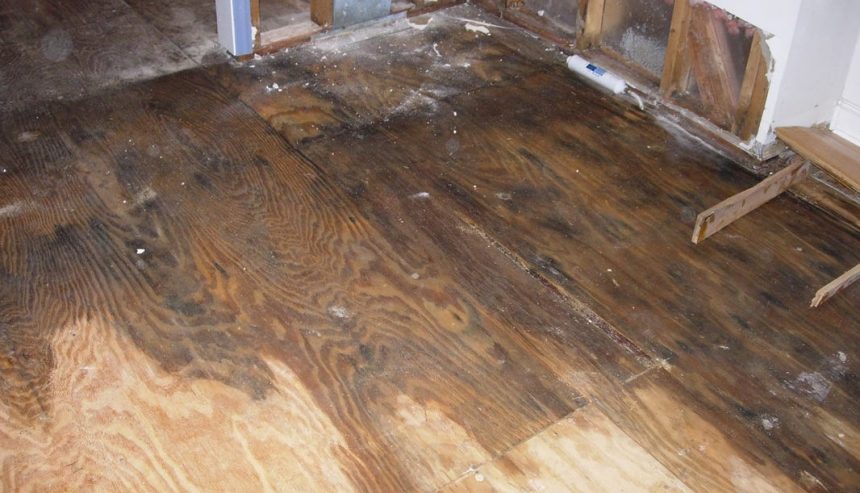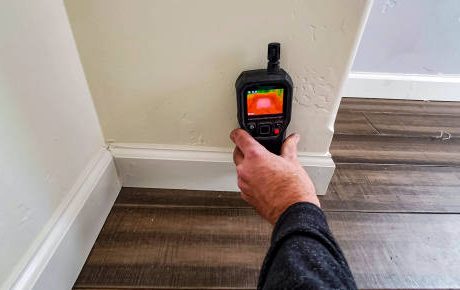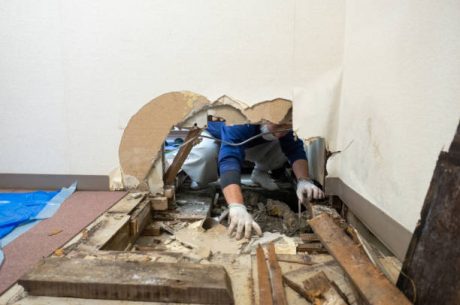Table of Contents
When your hardwood floors start whispering instead of creaking, it’s time to listen.
That faint musty odor… the slight rise in a floorboard… or the unexplained dark spot in a corner of the room—these aren’t just cosmetic quirks. In coastal homes like those in Santa Rosa Beach, they could be water damage signs pointing to something more dangerous: mold growing beneath your hardwood floors.
Whether it’s from a small leak, AC condensation, or a forgotten spill, water intrusion beneath wood flooring creates the perfect environment for mold to thrive. And once it’s under there, it’s hard to see—but even harder to ignore.
In this guide, we’ll show you how to spot the top water damage signs of mold beneath your hardwood, what causes it, and how PuroClean of Santa Rosa Beach can help restore your home and peace of mind.
Why Mold Loves Hiding Under Hardwood Floors
Hardwood floors are beautiful, durable, and timeless—but they’re also made of organic material. That means when water seeps underneath, it doesn’t just sit there—it gets absorbed.
In warm, humid climates like Florida’s Gulf Coast, moisture trapped under flooring creates ideal conditions for mold:
- Low ventilation
- Steady warmth
- Organic wood and dust as food
- Hidden environment (no UV exposure)
If you catch the damage early, you can often salvage the floor and prevent mold. But wait too long, and the issue may require complete floor removal and mold remediation.
7 Water Damage Signs That Mold Is Growing Under Your Hardwood
1. Warped or Buckled Floorboards
This is one of the most obvious water damage signs. When moisture seeps beneath the wood, it causes the boards to expand and push against each other.
What to look for:
- Raised seams or ridges
- Cupping (edges higher than the center)
- Crowning (center higher than the edges)
Buckled flooring is a major red flag—and may already indicate prolonged water exposure or mold growth beneath.
2. Discoloration or Dark Spots
Small dark or gray spots on your hardwood floor, especially in random places, can indicate mold. These marks often appear when mold starts to break through the surface of the wood.
Don’t assume it’s just wear and tear. If it’s accompanied by an odor or surface softness, call a professional to inspect it.
👉 Learn more about mold staining from the CDC
3. Musty Odors That Won’t Go Away
That damp, earthy smell that lingers in your home—even after you’ve cleaned? It’s often the first (and sometimes only) water damage sign that mold is active.
Hardwood floors can trap odors, especially if moisture has soaked into the subfloor or underlayment.
If you’ve ruled out obvious causes (like wet laundry or pets), trust your nose. Mold has a signature scent.
4. Soft or Spongy Spots When Walking
If you notice a section of your floor feels softer than the rest—or gives slightly under your feet—it could mean moisture has damaged the wood or subfloor.
In mobile or manufactured homes, this is a particularly common water damage sign, often from AC condensate leaks or plumbing drips that go unnoticed for weeks.
5. Visible Mold Around Baseboards or Floor Gaps
If mold is growing under your floor, it will eventually creep out where it can—often at the edges. Check baseboards and transitions for:
- Green, black, or white mold spores
- Cracking or separating caulk
- Moisture stains on adjacent walls
The EPA outlines mold color and health risks
6. High Indoor Humidity or Condensation
Even if you don’t see water pooling, consistent high humidity in your home can lead to hidden floor damage over time.
Install a digital hygrometer and keep your indoor humidity below 60%. Anything higher creates a perfect storm for mold under wood flooring.
Bonus tip: If you see condensation forming on your windows, your floor is also likely absorbing moisture.
7. AC or Appliance Leaks Nearby
If you’ve had a leaking dishwasher, fridge line, or AC unit nearby—even months ago—there could be moisture trapped under your floor that never fully dried.
Even clean water can cause mold if it lingers long enough.
If you didn’t have a professional dry the area, this is one of the most overlooked water damage signs that could point to trouble underfoot.
What Causes Water Damage Under Hardwood Floors in Santa Rosa Beach?
Coastal homeowners face unique challenges when it comes to moisture:
- Frequent summer storms and wind-driven rain
- High humidity year-round
- AC condensation line leaks
- Flooding or minor storm surges
- Leaky crawlspaces or old plumbing
Mobile homes and vacation rentals are especially vulnerable, as damage may go unnoticed during unoccupied months.
What Happens If You Ignore These Water Damage Signs?
Ignoring even small signs of moisture can lead to:
- Mold infestation (requiring full remediation)
- Subfloor rot and weakening
- Musty, unhealthy indoor air
- Decreased property value
- Higher repair and insurance claim costs
The earlier you act, the more affordable and less invasive the fix.
FAQs About Water Damage Signs and Mold Under Hardwood
Q1: How do I confirm if there’s mold under my hardwood floors?
A professional inspection using moisture meters and thermal imaging is the best way to detect hidden mold or trapped water.
Q2: Will homeowners insurance cover mold under floors?
It depends. If the mold resulted from a covered water event (like a sudden pipe burst), it may be covered. Gradual leaks usually are not.
Q3: Can I clean mold under the floor myself?
No. DIY cleaning can spread spores and increase exposure risk. Mold under floors requires proper containment and professional remediation.
Q4: What’s the difference between cupping and buckling?
Cupping = edges are raised. Buckling = entire board lifts from the subfloor. Both are water damage signs.
Q5: Can hardwood floors be saved after water damage?
Sometimes. If caught early and dried professionally, they can be salvaged. Otherwise, replacement may be necessary.

Protect Your Floors with Professional Water Damage Help in Santa Rosa Beach
If you’ve noticed any of these water damage signs—musty odors, buckling boards, or floor discoloration—it’s time to act.
At PuroClean of Santa Rosa Beach, we specialize in:
- Moisture detection under floors and walls
- Professional drying with air movers and dehumidifiers
- Mold containment and remediation
- Subfloor restoration and floor replacement
- Insurance claim support and documentation
📞 Call us today at (850) 399-3380 to schedule an inspection or emergency service. Our team is local, certified, and on-call 24/7.
Don’t wait until soft floors turn into a full-blown mold nightmare. Let’s get your home dry, safe, and strong—starting from the ground up.




 PuroClean of Santa Rosa Beach
PuroClean of Santa Rosa Beach